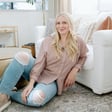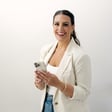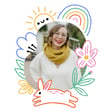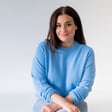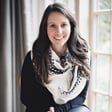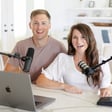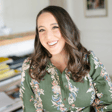Become a Creator today!Start creating today - Share your story with the world!
Start for free
00:00:00
00:00:01

Episode 217 - How to Choose the Perfect Colors for your Brand
Today on the podcast we're joined by our good friend and fellow Davey + Krista designer, Sara Metzger. Sara has been on the team for nearly 5 years and she is the genius behind many of the custom brands we create. We're walking you through the exact process we use to define aesthetics and ultimately create color palettes for our clients.
As always, links and resources can be found in the show notes. Check ’em out at https://daveyandkrista.com/how-to-choose-perfect-colors-brand-btb-217. And if you enjoyed this episode, please consider leaving a review over at Apple Podcasts.
Transcript
Brand Foundations: Color and Logo
00:00:00
Speaker
a lot of people remember color. That's what sticks with them when creating a brand. And a lot of people think about the logo and the color. And yes, your brand is made of much more than that. But if you can focus on nailing down the direction of the feel these colors create and what they kind of represent, I think that you have a really good foundation for creating a brand for yourself.
Introduction to Podcast and Guest
00:00:30
Speaker
You're listening to The Brands That Book Show, a podcast for creative entrepreneurs who want practical tips and strategies to build engaging brands and craft high converting websites. We're your hosts, Davey and Krista, co-founders of a brand and website design agency specializing in visual brand design and show it websites. You're listening to The Brands That Book Show.
00:00:52
Speaker
Today on the podcast, I'm joined by my good friend and fellow Dave and Krista designer,
Defining Aesthetics and Color Palettes
00:00:57
Speaker
Sarah Metzger. Sarah's been a part of our team for nearly five years and she's the genius behind many of the custom brands we create. Today we're walking you through the exact process we use to divine aesthetics and ultimately create color palettes for our clients. Whether you're DIYing your own brand, elevating your brand, or you're a designer looking to offer a better experience for your clients.
00:01:15
Speaker
client, this episode is full of practical tips to streamline the process. And if you want to watch me actually put these steps into practice with a real client's answers, head to daivianchristo.com slash brand questionnaire. And now on to the episode. Welcome to the podcast, Sarah. I just asked you before we hopped on this call, whether you've been on the podcast before, because you've been part of our team for
00:01:38
Speaker
Quite a while. You're like the genius behind so many of our brands on the team that come out of Dave and Krista and social graphics. And I can't believe that it's taken us this long to get you on the podcast.
00:01:53
Speaker
While I would love to show initiative and speak, this gets me nervous. I like to be creative behind the scenes. I like to be creative behind the scenes and not really show my face, but I am happy to be here. So thank you. So Davey and I have known Sarah since high school, middle school. We grew up with Sarah and her husband, Steve. We all did young life together in high school. So we've known Sarah a really long time and you are one of the funniest people I know. Your husband Steve is also really funny.
00:02:22
Speaker
When were you first wedding? Yes, you guys, if you don't know, I used to be a wedding photographer and Steve and Sarah were the very first wedding that I ever photographed and I had no idea what I was doing. You did a fantastic job. Thank you for taking a chance on me.
Creating Effective Color Palettes
00:02:37
Speaker
Yeah, it was amazing. So today we are talking about color palettes and how we create color palettes for the brands that we create and also for the websites that we create because some people come to us just are doing website design, but they still don't have a color palette.
00:02:54
Speaker
So we're going to dive into what we look for, how we put together. And then if you want like a jumpstart on all of this, we have a new free resource that you can grab. We'll link to it in the show notes, but it's the exact brand questionnaire that was in our clients. It's a breakdown that I go through teaching you like the theory behind each of the questions that we ask. And then you see me actually put together a mood board with all of the
00:03:18
Speaker
examples and sources. So you'll see everything that Sarah and I are going to talk about today in action. And so maybe it'll give you a jumpstart on your brand, or if you're another designer, like who just wants a little help, that could also be helpful. Okay. So like I just mentioned, every brand that we create starts with our branding questionnaire.
Client Engagement in Branding
00:03:37
Speaker
So I'd love for you to chat about some of the places that you look for inspiration when you're starting to think through the mood board and then eventually the color palette.
00:03:45
Speaker
Sure, yeah, yeah. Well, I love our brand questionnaire so much. The first thing I do is read that in its entirety to really get a feel for our client to understand the business history, why they do what they do, the name, their audience, all that. And then I really start to dive into them, the client. And first thing I think I do after reading the
00:04:12
Speaker
questionnaire is I check out their Instagram feed their Facebook their website and I look at their current imagery like on their feed or on their website and that really does give me a feel for what direction we're going right and lots of times in many cases they want to just elevate themselves so that really is a nice base for me yeah to go on and feel their aesthetic from there and then
00:04:41
Speaker
I mean, sometimes there are cases where they want a total brand revamp almost and they want to go in a totally different direction. Yeah. From like what you see on their current website or their Instagram. Yeah. Where do you look in those instances?
00:04:57
Speaker
Well, so sometimes they don't even have a social media too. And that kind of makes it a little bit difficult. Yeah. That's when I really reference I go back and look at each question of our brand questionnaire and their response. And one of the questions that we have on there is, you know, describe your the client avatar and they're like who they
Lifestyle and Branding Preferences
00:05:20
Speaker
are.
00:05:20
Speaker
where they shop, what they do for their career, and then I really start to get a feel from there. It's funny they say like what they hang on their walls or what they read or what's on their bookshelves and that really is so helpful for me to have that imagery in my head. Yeah. And then I get to pull from there.
00:05:38
Speaker
Yeah, I feel like somebody is going to have a really different brand if they say that like their walls are filled with family photos, maybe black and white, timeless photos versus someone who really loves like Monet and Impressionist art or more abstract art or think what else like vintage like found art. Yes, travel posters versus like family travels or like black and white imagery really helps me when they say I really want black and white imagery. Immediately I think of
00:06:08
Speaker
It can go in two directions, very family oriented, very loving, warm, or we want high end. And so that really starts to kind of point me in the direction of which way we're going with the colors and the imagery I'm going to pull. Yeah. What about like where they shop? Like how do you use that information to find imagery and colors? Yeah.
00:06:30
Speaker
It's funny. And it's also really cool to look at the collective like who shops where and anthropology does come up a lot. And if you look at those two, for instance, pottery barn is very kind of put together and buttoned up. Yeah, but has like a little bit of a relaxed feel to and a lot of their products. But anthropology is like a little bit more free and fun and funky and
00:06:57
Speaker
I start to think about a lot of color there, while the color palette for Pottery Barn, for instance, is limited, warm, and inviting, and softer. Yeah, I feel like you can even go into some of their products and look at the color swatches that they have in there, and that might give you a good idea of colors. And so I think that's why we always ask about who your ideal client is, because the more that you can hone in on an actual person and think about
00:07:27
Speaker
how they spend their free time, what is important to them, what they already are surrounding themselves with.
Target Audience and Branding
00:07:33
Speaker
It's going to be so much easier to develop a brand that is going to appeal to that ideal person because ultimately when we're creating brands, we're not so much creating them for our clients. Yes, we want them to love them, but hopefully we're creating it for their ideal clients to love.
00:07:50
Speaker
Yes, absolutely. And it's funny because when you read a lot of our questions, they say, I don't know really how I'm supposed to answer this. Am I answering it for myself or for my clients? And I tend to read what they say for their clients.
00:08:05
Speaker
That's who they're representing. Yeah. And I mean, when we were photographers, we realized pretty early on that our ideal clients were not necessarily us. Maybe they were a little more me than like Davey. And this is because when we ended up
00:08:21
Speaker
Like our photography career is like fairly high-end photographers. But yeah, Davy always had a bag of Sour Patch Kids in his camera bag and he wanted to get Wawa on the way to the shoot. And as soon as we got home, he put on his sweatpants with holes in them and then his like go-to on the way home. And I feel like we got to a point where our clients even knew this was in McFlurry.
00:08:45
Speaker
Like sometimes we went to multiple at McDonald's to find him like a very specific flavor of McQuarrie, but like we didn't put any of that on our website because that would not have appealed to our clients. So we weren't trying to create a brand that was Davey. I think it was more like trying to create a brand that was more ideal clients.
00:09:05
Speaker
Yes, absolutely.
Case Study: Cafe Pronto Branding
00:09:07
Speaker
Do you have any really strong examples of brands that you've worked on recently that you could give us an example of a client avatar that really stood out to you and help you develop something unique? Okay, let me think about this. Maybe Cafe Pronto. I was just thinking about that. Okay, so I absolutely love their brand.
00:09:30
Speaker
They're fun and I really related to it. Actually kind of I always have these ideal clients in my head that I love to design for and so they were I think definitely one of them where they gave us a little bit of leeway on our end but what they described was they were Italy based so Italian influence
00:09:55
Speaker
fun, inviting, they wanted to gather around a table, sit and talk with friends. But one of the things that they described in their questionnaire was they, I actually love that they did this because it was exactly what I had in mind for them, was they wanted a punchy red. They didn't know any other colors. We were elevating their brand from what they had. So we were already working with a blue color.
00:10:20
Speaker
But they wanted a punchy red. Otherwise, they said, can you gather what you know from what we've described in our brand? And I was thinking exactly a punchy, like, orangish red color. And I loved the direction they were going. So I think that when I think Italy, I think like pizza sauce, like red sauce, I think like those little red, I think they have one of these cars, a Fiat.
00:10:45
Speaker
Is that what it is? They kind of look like a Volkswagen Beetle, but way more Italian and way cooler. And so I think that was fun to see all of that together.
Tools for Branding Inspiration
00:10:57
Speaker
Absolutely. I immediately thought of the blue of the sea against some of the white and cream buildings, and then the red that is in a lot of the local shops' signage. And so I was pulling from that immediately.
00:11:13
Speaker
And they wanted to keep things local. And so that kind of went in line with the small shops of Italy, a small town feel, gathering, comforting, fun, a little quirky. Right. Yeah. It was a lot of fun to create their brand.
00:11:29
Speaker
So I don't know about you, but when I'm going through a brand and questionnaire to work on a mood board, I often just start putting some of the words that they're saying into Pinterest or like if they say anthropologies where their client would shop or made well, I might go to that company's Instagram and see what kind of visuals are there. And I feel like just with all of that searching, sometimes I stumble on other inspiration sources that they may not have referenced or that I may not have referenced.
00:11:56
Speaker
Like especially on Pinterest if you type in like anthropology like maybe you go to their their boards and like maybe you find an image that you really like and you click on it but then if you scroll down that takes you to other images that are related and so sometimes I find really cool things that way.
00:12:12
Speaker
Is your process similar? That's exactly how I do it. I also think just my travels have really influenced what I pull. I love Charleston and so and a lot of our clients reference Charleston so I just have a lot of little shops that I love there or artists that I love there and so I pull a lot from there.
00:12:35
Speaker
With Pinterest, I've actually kind of made a personal private board called mood board images. I just see along the way too and I pin them for possible use in our clients color palettes and mood boards and that's always something I reference in cases also where I'm not given much information or we want to go in a totally different direction.
00:13:01
Speaker
Yeah, I pull from their imagery. This is, I don't know if we're kind of going off on this, but if I really don't have a lot, I bank on their, hopefully we ask them to provide their own Pinterest private board too. So I go on that.
00:13:20
Speaker
Or I pull from their Instagram and I even like looked at their tagged images and see who follows them or because that usually kind of is in the same realm of who their client is and who likes them. Yeah, those are all good ideas. I also have a secret Pinterest board that I like you. I just save design examples or patterns or like fonts or things that stand out to me. And sometimes you just need to go through that and just see what maybe pops
00:13:49
Speaker
out at you because one thing I think we both try to include in these mood boards is maybe like a hint at fonts and like the fonts are by no mean final at this point it's really just like pointing out we do a hand-drawn script would that fit with your aesthetic or would a clean sans sour fork batter because I feel like that also gives a client kind of an idea of where we're gonna go with the brand and it also kind of tells us if they're gonna like that or if they're not gonna like that
00:14:15
Speaker
Yeah it also breaks up the visual of the mood board too. When you have picture after picture after picture it kind of can get busy and so throwing in a typeface in there that on the color background that that we want to include really helps lots of times
00:14:33
Speaker
Putting in there a drawing or like a sketch illustration within the mood board really helps break it up, give it some breathing room, but also, you know, it's very in line with where they want to go and the direction they want for their brand. Yeah.
00:14:49
Speaker
I think that the artwork can really help break stuff up like you mentioned too and that is one of the questions that we ask people like what kind of art hangs on their walls and we'll look for artists and then I think that our team members also typically have a lot of artists that we follow just like being designers and so we always reference from there too. So once we have like a good pool of images to choose from, what is the next step in the process?
00:15:13
Speaker
Okay, so I like to gather those images and sort of, if I already have an idea of the direction of colors I want to go in, I sort of start choosing images with those same colors or brightness or, you know, warm tones, and then start to include those.
00:15:35
Speaker
In many ways I also will look at the client's own images if I really want another color and I will screenshot their Instagram feed and I'll pull it into Photoshop and I'll do like a glossy and blur on it and then I'll pull colors from there like what really sticks out.
00:15:54
Speaker
So I'll do that. And also, I mean, like, if I find, for instance, and we've done this a couple of times, a typeface that I really want to include that really speaks to their brand or the direction they want to go. And maybe it's on a different background that we don't really want to include in their mood board color. I will change that in Photoshop. I've done that too, or like made it black and white.
00:16:17
Speaker
Right, right, exactly. So you're not necessarily stuck to exactly what you find on the internet or on Pinterest. Yeah, I typically, I try to source like 20 to 30 like starter reference images, and then I open all of them up in Photoshop at the same time, which probably gives some people anxiety to have that many tabs open. And then it works 72 tabs up all for inspiration.
00:16:44
Speaker
I have a lot too. Maybe it's just a designer thing. Anyway, I then open up my Photoshop PSD mood board template that we all use. You can grab this too in our free download. And I start to just copy images into the file and place them in. And like you said, kind of see what fits together, alternating image types, like
00:17:04
Speaker
busy with less busy, including some examples of their work, including some examples of typography and colors. And then from there, I think like you, I like to eye drop colors from the actual images. And you don't always get that like 100% right. Sometimes like you'll be going for green and you have to tweak your green a little bit too. But I think it is a good starting point.
00:17:28
Speaker
Absolutely. Two things you said, including their imagery that they already have or they already own.
Choosing Colors for Branding
00:17:35
Speaker
I really like to do that and put that in their mood board, at least two to three images. One, because it shows them, well, they recognize it immediately. Oh, that's mine. And like, this is my mood board. Two, it shows that we've dug deeper and we are pulling from what they have produced. And these images,
00:17:56
Speaker
especially to us kind of represent the direction we're going to go with them. Because it's like this direction, like also automatically works with your brand. I think it helps them visualize it like you're saying. Yeah, absolutely. Do you ever use any like other color palette generators? Like I know there are a lot of online generators. Lots of times in the brand questionnaire, they'll say, I want citrus tones. And I'm like, what?
00:18:25
Speaker
I don't know about, so I will type in like citrus tones just to get an idea online, just to get an idea of, you know, what Google has to say about what are citrus tones. And I have my idea of what they are, but maybe there are a few others that I can pull. Or I usually like to include, I don't know,
00:18:43
Speaker
it can range up to like six to eight to 10 colors for their color palette. And those colors can be distributed in different ways. And I think we're going to talk about that. But sometimes I have, you know, six colors already, I want to add a few more. And so I go on Google and I'm like, what looks good with emerald green, right? Or it really also kind of
00:19:08
Speaker
influences the color palette from how they've described their brands. If they say, I want a warm, welcoming atmosphere, I want something that's inviting, but they're going in a green direction, I will tend to go tonal. Maybe they have their green and then I'm going to do a lighter green and maybe I'm going to do a muted green. Maybe I'm going to do a super deep green for background colors or text or something like that.
00:19:38
Speaker
So I really am pulling from all these sources to try and figure out, you know, which direction we're going to go with these colors and remembering, you know, what they put in their brand questionnaire versus how their images look online already. Do they match up? Do you ever use like Adobe has a color generator tool online? Do you ever use those or do you find that they're not helpful?
00:20:03
Speaker
I do in cases where I'm like, I don't know what else to do. And that has been helpful. But for the most part, I kind of just stick to what we've been talking about. And it seems to have been really working so far. That human element behind all of it, I think really I'm taking so many things into consideration when I'm choosing your colors. Right.
00:20:30
Speaker
versus something that's automated will do. Sometimes I will take a color, like if I know there's a color I really like and Adobe Illustrator has these color palette generators built in. And so you can do like complimentary tones and analogous tones. And there's like a bunch of different options there. And I feel like sometimes it helps me find like a good brighter color or a good lighter complimentary color just to vary a palette a bit more.
00:20:58
Speaker
Yes, absolutely. So you mentioned this a little bit, but are there some tones or colors that you always include when you're doing a mood board? I like to include usually a darker color, a black or a charcoal, probably for text for their website or for other print materials they would want to use.
00:21:17
Speaker
I usually go with a lighter tone too, a super lighter tone, maybe a cream or a white. Sometimes they have included on their brand questionnaire that they do want to go black and white. So I do put that in there. Right. But to elevate that a little bit more, I like, let's say we want to go black and white, then I will throw a cream in there. It feels elevated too. It still really complements the black and white.
00:21:42
Speaker
you know it gives a deeper tone to the color palette but i also consider everything that they're going to be using this color palette for right for their website for their print materials for their social so i keep that in mind and i choose colors that they can use for their backgrounds or you know
00:22:03
Speaker
their website a highlight color something that's going to catch their eye on the website a complementary color maybe they need a call to action color for their social and you know they use it for their button so you know having a color that's going to really like catch your eye for that you know i consider all of that when creating the color palette
00:22:28
Speaker
And you know, it really helps if they list it. A lot of our clients do in the brand questionnaire and it's super helpful that they include that within the process. And that's always a starting point for me because they probably are not thinking. I need a button color. Exactly. They're probably not thinking about any of that. They know, for instance, how to sell pastries and ice cream and
00:22:53
Speaker
we're there to help with everything else. So I make sure that there's also a lot of wiggle room too. I think of you when creating the websites or I think of what their logo is going to look like on the website. And lots of times if they really want a lighter color palette in general, we'll do that for the mood board, but that doesn't necessarily mean that
00:23:16
Speaker
we're going to one hundred percent stick to those colors yeah i think that we found a lot of times in the process if their color palette is like really light and soft for example like you can't do a really softly logo and still happy readable.
00:23:32
Speaker
can't see it and we do the test of lowering our screen to black to be able to see will this logo
Adaptability and DIY Branding
00:23:41
Speaker
you know can you see it on your computer because we don't know the brightness or the darkness that people are looking at their phones or your computer at so if they do a very soft lighter color palette
00:23:53
Speaker
We will definitely grab from those colors, but maybe tone it down a little bit and make it a deeper tone of whatever those colors are for your logo. Yeah, I think that one thing we've realized is that you can't be married to the initial color palette just because sometimes it does need to be tweaked a little bit in the design process. Right, exactly. Just as long as we, meaning us and the client are happy with the direction we're going, we can move forward.
00:24:22
Speaker
Do you think that this is a process that somebody could do for themselves even if they're not a designer? Or do you think it'd be hard? I think they definitely could pick up these different things. But it honestly takes a lot of practice for us. But I think listening to us talk about this or trying it out for themselves using our resources and stuff, I think that they absolutely can try.
00:24:51
Speaker
It's really good to listen to what we're considering in the design process, not only the colors, but what goes into that and what these colors could possibly be used for. But absolutely, I mean, try it and consider everything. Consider background, consider logo, consider text color, consider, you know, something that's going to grab your attention.
00:25:15
Speaker
Yeah, I think that if you have a brand new brand or you're just getting started, if you just don't have like the budget right now to invest in a brand, this is definitely something that you could do for yourself. Like we said, we have a free resources that you can grab our exact brand in question here, watch me walk through it, and then actually put a mood board together. And that might be a really good start for you. Even if you are going to work with a designer later in the process, like later in your business,
00:25:42
Speaker
This might give you a firm foundation and help you to figure out just how to guide your designer and how to make decisions. It can feel super overwhelming if you're at that point. Yeah. Starting out by pulling colors, pulling images, and just focusing on that right away and then maybe plugging them into the mood board template that we have and just focusing on that step at a time. Right.
00:26:08
Speaker
is more digestible than like, I'm starting a new brand and I like this and I want to market this and I want to put this out there. But the color when you have that base, that's a huge starting point, a huge foundational jumping off point. I mean, a lot of people remember color. That's what sticks with them when creating a brand. And it's a lot of people think about the logo and the color and
00:26:36
Speaker
Yes, your brand is made of much more than that, but if you can focus on nailing down the direction of the feel these colors create and what they kind of represent, I think that you have a really good foundation for starting off and updating or creating a brand for yourself. Yeah. Well, thank you for joining me, Sarah. Davey's going to laugh when he sees that we talked about colors for over 30 minutes.
00:27:06
Speaker
This was a lot of fun, though, I will say. My anxiety now. OK, good. Well, I'm going to have to have you back on the podcast again soon, because I feel like there are so many just different designer things that we could get into and nerd out about. And I really appreciate you sharing all of your design wisdom. Thanks, Krista. This was fun. Yeah, I appreciate it. Well, thanks, Sarah. Yeah, see ya.
00:27:29
Speaker
Thanks for tuning in to the Brands of Book Show. If you enjoyed this episode, please consider subscribing, leaving a review on Apple Podcast, and sharing this episode with others. For show notes and other resources, head on over to davianchrista.com.


